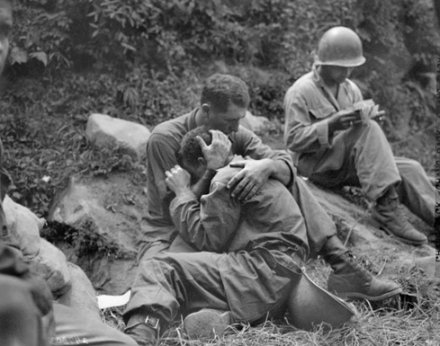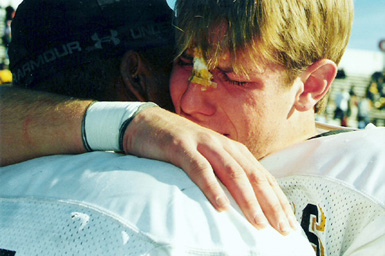Crying

Crying (also called sobbing, weeping, wailing, whimpering, bawling, and blubbering) is shedding tears as a response to an emotional state in humans. The act of crying has been defined as "a complex secretomotor phenomenon characterized by the shedding of tears from the lacrimal apparatus, without any irritation of the ocular structures".[1] The medical term for this is to lacrimate, which also refers to non-emotional shedding of tears.
A neuronal connection between the lacrimal gland (tear duct) and the areas of the human brain involved with emotion has been established. Some scientists believe that only humans produce tears in response to emotional states [2] while others disagree.[3] Charles Darwin wrote in The Expression of the Emotions in Man and Animals that the keepers of Indian elephants in the London Zoo told him that their charges shed tears in sorrow.
In many cultures, it is more socially acceptable for women and children to cry, and less socially acceptable for men to cry.[2]
Tears produced during emotional crying have a chemical composition which differs from other types of tears. They contain significantly greater quantities of the hormones prolactin, adrenocorticotropic hormone, Leu-enkephalin[4] and the elements potassium and manganese.[2]
Contents[hide] |
Function

The question of the function or origin of emotional tears remains open. Theories range from the simple, such as response to inflicted pain, to the more complex, including nonverbal communication in order to elicit "helping" behavior from others.[5] Some have also claimed that crying can serve several biochemical purposes, such as relieving stress and releasing toxins from the body.[6] However, this view has recently come into question by psychologists who feel that the only reason people believe they think more clearly with a "good cry" is due to social influence. Also, individuals tend to remember the positive aspects of crying, and may create a link between other simultaneous positive events, such as resolving feelings of grief. Together these features of memory reinforce the idea that crying helped the individual.[7]
In Hippocratic and medieval medicine, tears were associated with the bodily humors, and crying was seen as purgation of excess humors from the brain.[8] William James thought of emotions as reflexes prior to rational thought, believing that the physiological response, as if to stress or irritation, is a precondition to cognitively becoming aware of emotions such as fear or anger.
William H. Frey II, a biochemist at the University of Minnesota, proposed that people feel "better" after crying due to the elimination of hormones associated with stress, specifically adrenocorticotropic hormone. Crying has since then been linked to a burst of intense emotional sensations, such as extreme pain or joy.[9] This, paired with increased mucosal secretion during crying, could lead to a theory that crying is a mechanism developed in humans to dispose of this stress hormone when levels grow too high.
Recent psychological theories of crying emphasize the relationship of crying to the experience of perceived helplessness.[10] From this perspective, an underlying experience of helplessness can usually explain why people cry. For example, a person may cry after receiving surprisingly happy news, ostensibly because the person feels powerless or unable to influence what is happening.
Emotional tears have also been put into an evolutionary context. One study proposes that crying, by blurring vision, can handicap aggressive or defensive actions, and may function as a reliable signal of appeasement, need, or attachment.[11] Dr. Oren Hasson, an evolutionary psychologist in the zoology department at Tel Aviv University explains that crying shows vulnerability and submission to an attacker, solicits bystanders for sympathy and aid and signals shared emotional attachments.[12]
Another theory that follows evolutionary psychology is given by Paul D. MacLean, who suggests that the vocal part of crying was used first as a "separation cry" to help reunite parents and offspring. The tears, he speculates, are a result of a link between the development of the cerebrum and the discovery of fire. MacLean figures that since early humans must have relied heavily on fire, their eyes were frequently producing reflexive tears in response to the smoke. As humans evolved and began to say "Rest in Peace" to their dead, the smoke possibly gained a strong association with the loss of life and, therefore, sorrow.[13]
Biological response
It can be very difficult to observe biological effects of crying, especially considering many psychologists believe the environment in which a person cries can alter the experience of the crier. However, crying studies in laboratories have shown several physical effects of crying, such as increased heart rate, sweating, and slowed breathing. Although it appears that the type of effects an individual experiences depends largely on the individual, for many it seems that the calming effects of crying, such as slowed breathing, outlast the negative effects, which could explain why people remember crying as being helpful and beneficial.[14]
A common side effect of crying is feeling a lump in the throat of the crier, otherwise known as a globus sensation.[15] Although many things can cause a globus sensation, the one experienced in crying is a response to the stress experienced by the sympathetic nervous system. When an animal is threatened by some form of danger, the sympathetic nervous system triggers several processes to allow the animal to fight or flee. This includes shutting down unnecessary body functions, such as digestion, and increasing blood flow and oxygen to necessary muscles. When an individual experiences emotions such as sorrow, the sympathetic nervous system still responds in this way.[16] Another function increased by the sympathetic nervous system is breathing, which includes opening the throat in order to increase air flow. This is done by expanding the glottis, which allows more air to pass through. As an individual is undergoing this sympathetic response, eventually the parasympathetic nervous system attempts to undo the response by decreasing high stress activities and increasing recuperative processes, which includes running digestion. This involves swallowing, a process which requires closing the fully expanded glottis to prevent food from entering the larynx. The glottis, however, attempts to remain open as an individual cries. This fight to close the glottis creates a sensation that feels like a lump in the individuals throat.[17]
Frequency of crying
According to a study of over 300 adults, on average, men cry once every month; women cry at least five times per month,[2] especially before and during the menstrual cycle when crying can increase up to five times the normal rate, often without obvious reasons (such as depression or sadness).[18]
According to the German Society of Ophthalmology, which has collated different scientific studies on crying, women cry on average between 30 and 64 times a year, and men cry on average between 6 and 17 times per year.
Men tend to cry for between two and four minutes, and women cry for about six minutes. Crying turns into sobbing for women in 65% of cases, compared to just 6% for men. Until adolescence, however, no difference between the sexes was found.[19]
Types of crying in infants

Although crying is an infant's mode of communication, it is not limited to a monotonous sound. There are three different types of cries apparent in infants. The first of these three is a basic cry, which is a systematic cry with a pattern of crying and silence. The basic cry starts with a cry coupled with a briefer silence, which is followed by a short high-pitched inspiratory whistle. Then, there is a brief silence followed by another cry. Hunger is a main stimulant of the basic cry. An anger cry is much like the basic cry; however, in this cry, more excess air is forced through the vocal cords, making it a louder, more abrupt cry. This type of cries is characterized by the same temporal sequence as the basic pattern but distinguished by differences in the length of the various phase components. The third cry is the pain cry, which, unlike the other two, has no preliminary moaning. The pain cry is one loud cry, followed by a period of breath holding. Most adults can determine whether an infant's cries signify anger or pain.[20] Most parents also have a better ability to distinguish their own infant's cries than those of a different child.[21] A 2009 study found that babies mimic their parents' pitch contour. French infants wail on a rising note while the Germans favor a falling melody.[22]
Categorizing dimensions
There have been many attempts to differentiate between the two distinct types of crying (one negative and one positive). Different perspectives have been broken down into three dimensions to examine the emotions being felt and also to grasp the contrast between the two types.[23]
Spatial perspective explains sad crying as reaching out to be "there," such as at home or with a person who may have just passed away. In contrast, joyful crying is acknowledging being "here." It emphasized the intense awareness of one's location, such as at a relative's wedding.[23]
Temporal perspective explains crying slightly differently. In temporal perspective, sorrowful crying is due to looking to the past with regret or to the future with dread. This illustrated crying as a result of losing someone and regretting not spending more time with them or being nervous about an upcoming event. Crying as a result of happiness would then be a response to a moment as if it is eternal; the person is frozen in a blissful, immortalized present.[23]
The last dimension is known as the public-private perspective. This describes the two types of cryings as ways to imply details about the self as known privately or one's public identity. For example, crying due to a loss is a message to the outside world that pleads for help with coping with internal sufferings. Or, as Arthur Schopenhauer suggested, sorrowful crying is a method of self-pity or self-regard, a way one comforts oneself. Joyful crying, in contrast, is in recognition of beauty, glory, or wonderfulness.[23]
Lacrimal system

There are three types of tears: basal tears, reflexive tears, and psych tears. Basal tears are produced at a rate of about 1 to 2 microliters a minute, and are made in order to keep your eye lubricated and smooth out irregularities in the cornea. Reflexive tears are tears that are made in response to irritants to your eye, such as when chopping onions or getting poked in the eye. Psych tears are produced by the lacriminal system and are the tears expelled during emotional states.[24]
The lacrimal system is made up of a secretory system, which produces tears, and an excretory system, which drains the tears. The lacrimal gland is primarily responsible for producing emotional or reflexive tears. As tears are produced, some fluid evaporates between blinks, and some is drained through the lacrimal punctum. The tears that are drained through the punctum will eventually be drained through the nose. Any excess fluid that did not go into the punctum will fall over the eyelid, which produces tears that are cried. [25]
- Bell's palsy, where faulty regeneration of the facial nerve can cause sufferers to shed tears while eating.[26]
- Cri du chat, where the characteristic cry of affected infants, which is similar to that of a meowing kitten, is due to problems with the larynx and nervous system.
- Familial dysautonomia, where there can be a lack of overflow tears (alacrima) during emotional crying.[27]
- Pathological laughing and crying, where the patients experience relatively uncontrollable episodes of laughing or crying, or both.
https://en.wikipedia.org/wiki/Cry
When Is It Okay for a Man to Cry?

Image from Seattletim
Men are known as the less emotional sex; they are bastions of stability; the rock in the middle of a storm; unflappably cool no matter what the circumstance. Of course, it’s not wrong for men to get emotional. It’s unhealthy to keep one’s feelings bottled up and shoved deep down inside. But when is it okay for a man to display his emotions through crying?
The History of the Man Cry
Men have always cried. Yet the acceptability of male crying has varied across time and across culture. There are many references to man tears in ancient Greek and Roman culture. In Homer’s The Iliad there is no conflict between Odysseus’ heroic qualities and the inclusion of many episodes of his weeping for home, loved ones, and fallen comrades. Yet Odysseus never breaks down out of loneliness or frustration, which the ancient Greeks did not feel were acceptable reasons for men to cry. They also expected warriors to understand that there were times when public displays of emotion were acceptable, and times when it was appropriate to cry alone. Odysseus frequently tries to hide his tears from those around him.
The Old Testament is similarly replete with references to weeping. The ancient Hebrews wept as part of their supplications to God and before going to battle. The Gospel writers did not feel that tears were a threat to either the manhood or godhood of Christ and dutifully recorded that “Jesus wept.” Perhaps drawing inspiration from this emotional display, early church thinkers considered tears a gift and a natural accompaniment to spiritual, even transcendent, experiences. The great theologian Thomas Aquinas, like the ancient Greeks, made the distinction between the very public weeping that had characterized Hebraic culture, and the idea that it was frequently best to cry away from people’s prying eyes.
Medieval Japanese and European epics are chock full of male crying. The great warriors in both Beowulf and the Tale of Heiki cry buckets over both great spiritual questions and the death of comrades. The warriors in such stories are expected to cry about issues of war, peace, and ideals, while the women weep over romantic and platonic relationships or out of general sadness, loneliness, or frustration.
Up through the Romantic Era, a permissive, even celebratory attitude toward male crying prevailed. Popular culture was of full of sentimental literature and art featuring men and women falling into each other’s arms and bathing one another with their tears. Tears were seen as proof of a man’s sincerity, honesty, and integrity. The Enlightenment ushered in a more rational ideal of manhood. Tears came to be seen not as an unmitigated virtue, but as sometimes manipulative, illogical, and false.
During the Victorian Era, those virtues thought to be exclusively feminine in nature were celebrated. Women were seen as dainty and fragile, full or emotion and love. Tears have always had a vulnerable and submissive quality to them, and began to be seen as more befitting a man than a woman. As the 20th century emerged, the ideal of the tearless male emerged with it.
The Man Cry Today
Culture’s view of male crying has continued to evolve into our day. While we still expect men to cry less than women, in some cases it has now become more acceptable for a man to cry than a woman, at least when it comes to our public officials. Hillary Clinton’s tears in New Hampshire brought some compassion, but also criticism that such vulnerability made her ill suited for leadership. Yet Mitt Romney choked up several times on various news programs without the slightest attention being paid to it. Many see tears as a proof that a man is sensitive and humble and thus well rounded.
Which leaves men in a gray area when it comes to crying in the modern age. Some people these days encourage men to let loose whenever the urge hits. Some adhere to the “you can’t squeeze tears from a stone” philosophy. I think the key to man crying lies somewhere between these two edicts. A man need not be perpetually stoic. There are, of course, times when we feel sorrow or frustration so acutely that it must be let out. Yet there’s a balance between being so sensitive that a Hallmark commercial can make you weep and shedding some tears over something truly significant. Just as there is a balance between releasing some man tears and turning into the kind of blubbering mess that makes everyone feel uncomfortable. Here are some appropriate and inappropriate times to get your cry on.
When It’s Okay For a Man to Cry

Photo by richelleantipolo
1. The death of a loved one. There are few things more painful that the thought of separation from those dearest to our hearts.
2. The death of your beloved pet. A pet can feel like a member of the family. Whether a horse or dog, the bond between a man and his faithful animal runs deep.
3. When you first see the new life you and your wife created. Many a man has found himself choked up as they cradle their newborn son or daughter.
4. When you propose to the love of your life and she says yes. This should be one of the happiest days of your life. You found your best friend.
5. At the altar as you get married. Everyone in attendance loves to see the husband-to-be get a little misty eyed as his blushing bride walks down the aisle.
6. When your beloved car or truck, especially your first one, gets totaled. There’s a bond between a man and his wheels that when severed, can really sting.
7. Visiting sites that pay tribute to those who laid down their lives for others. Whether running your fingers over the names at the Vietnam War Memorial or watching the oil leak from the sunk USS Arizona, contemplating the sacrifices made by your fellowman should make you tear up.
8. Describing a really spiritual experience. Feeling touched by a higher power can be really affecting.
9. As an athlete, after the final game/match/event that you will ever play in. You’ll never be in as good shape again. You’ll never experience this level of camaraderie again. You’ll never push yourself so hard every day. Go on and let it out.
10. While watching any of the following movies:
- Field of Dreams
- Brian’s Song
- Shawshank Redemption
- The Pride of the Yankees
- Old Yeller
- Iron Giant
- Life is Beautiful
- Saving Private Ryan.
- Rudy
- Braveheart
- Dead Poets Society
- Friday Night Lights
- We Were Soldiers
- Gladiator
- Butch Cassidy and The Sundance Kid
- The Champ
- Glory
- It’s a Wonderful Life
When It’s Not Okay For a Man to Cry

Devotion to your team is respectable. Turning into a blubbering mess when they lose, not so much.
1. When you favorite sports team loses. I get really into sports. But crying when men who don’t know you from Adam lose a game means you’ve got way too much invested.
2. When those around you are looking to you as a source of calmness and strength. Sometimes your loved ones need you to be a rock.
3. To the point of irrational thinking or paralysis when you have a job to do. I wanted to strangle Upham in Saving Private Ryan when he cried in the stairwell while his fellow soldier was being killed. When you have a job to do, get it together.
4. When you don’t get your way. Little boys cry when they don’t get what they want. Men are disappointed, but resilient.
5. When you’re frustrated. Crying because your overwhelmed and don’t know what to do is a cop out. You don’t have the strength to think of a solution, so you cry so you don’t have to think at all. Man up and figure out your next move.
6. In baseball. There’s no crying in baseball!
7. During any of the following movies:
- Beaches
- Steel Magnolias
- Little Women
- Jerry Maguire
- The Notebook
- Ghost

No comments:
Post a Comment